
How Do Ecommerce Product Reviews Boost Trust and Credibility?
[Updated on June 09, 2025] Did you know that most consumers often read online reviews before buying a product? A single one-star rating increase can boost your revenue. Ecommerce product reviews are key business assets that influence customer trust, engagement, & success.
This article provides valuable and necessary ecommerce product review strategies.
-
Top 7 Product Review Sites To Consider for Your Ecommerce Business
-
8 Best Practices to Make the Most of Your Ecommerce Product Reviews
-
Tips to Set Up Ecommerce Product Reviews on Your eCommerce Website
Why Do Product Reviews Matter In Ecommerce?
1. Sales
Product reviews play a key role in driving ecommerce sales. They provide customers with valuable insights into a product's quality, function, and satisfaction. Products with 5 or more reviews are 270% more likely to sell. They provide reassurance and reduce buying hesitation.
User-generated evaluations help customers feel more comfortable and confident about their purchasing decisions. They can also help choose one product over another if the thoughts are better. A one-star rating increase can boost revenue by 5-9%. It shows the direct financial impact of positive reviews.
2. Trust
Trust is necessary for a successful e-commerce business. Product reviews help establish trust with customers. They showcase honest opinions and feedback from individuals who have used the products.
A mix of good and bad reviews can even strengthen trust. Verified buyer badges show that stores are trustworthy and assess customer satisfaction. Adding photos or videos to reviews helps people trust the product even more.
3. SEO
Product reviews are key in enhancing your e-commerce site's SEO efforts. Many reviews enable search engines like Google to identify more keywords. This approach yields a better search ranking & attracts more visitors to your website. Including photos or videos in reviews can also help. They encourage people to stay on your site longer, which in turn leads to better SEO and highlights the value of white label SEO services.
4. Customer Decision-making
Reviews help people make informed decisions about what to buy. For example, imagine someone wanting a "new laptop" but unsure of what to buy. They can read reviews from others who bought the computer and decide based on what those people say.
Businesses need to understand that displaying excellent and honest reviews is necessary. This process will help people trust their brand and buy their products. Even negative reviews can be beneficial if companies respond to them in a kind and helpful way. Valuing opinions and using that feedback helps enhance a business's products and services.
5. Customer Service
Reviews often reveal how customers feel about their interactions with your team. If people mention delays in email responses, that's a sign to improve your support workflow. For example, consider setting a "24-hour reply policy".
6. Product Quality
Comments about 'fit', 'function', or 'design' give clear signals. For instance, if customers have sizing issues, consider creating a detailed size guide. You can also adjust your product designs to achieve a better fit. If many customers highlight a specific feature, add it to more products in your lineup.
7. Pricing
Feedback can also guide pricing decisions. Customers often highlight your product's strong value when compared to more expensive competitors. This process could reveal a chance to raise your prices. If cost is a common complaint, consider enhancing quality/packaging/lowering the price.
8. Shipping Experience
Shipping issues are a common pain point. Complaints about 'delays' or 'limited options' may denote that it's time to switch providers. Consider expanding delivery options to better meet customer expectations.
3 Types Of Ecommerce Product Reviews
1. Positive Reviews

Positive reviews are necessary for establishing trust with potential customers & driving sales. They help raise your presence on search engines & increase organic traffic. A mix of feedback is more trustworthy to potential customers.
2. Negative Reviews

While negative reviews may concern e-commerce businesses, they also offer valuable insights. Customers expect a mix of positive & negative reviews when making a checkout decision. This flexibility helps establish credibility.
Negative reviews enable businesses to improve their products/services. When responding to these reviews, be prompt/courteous/solution-focused.
3. Picture And Video Reviews
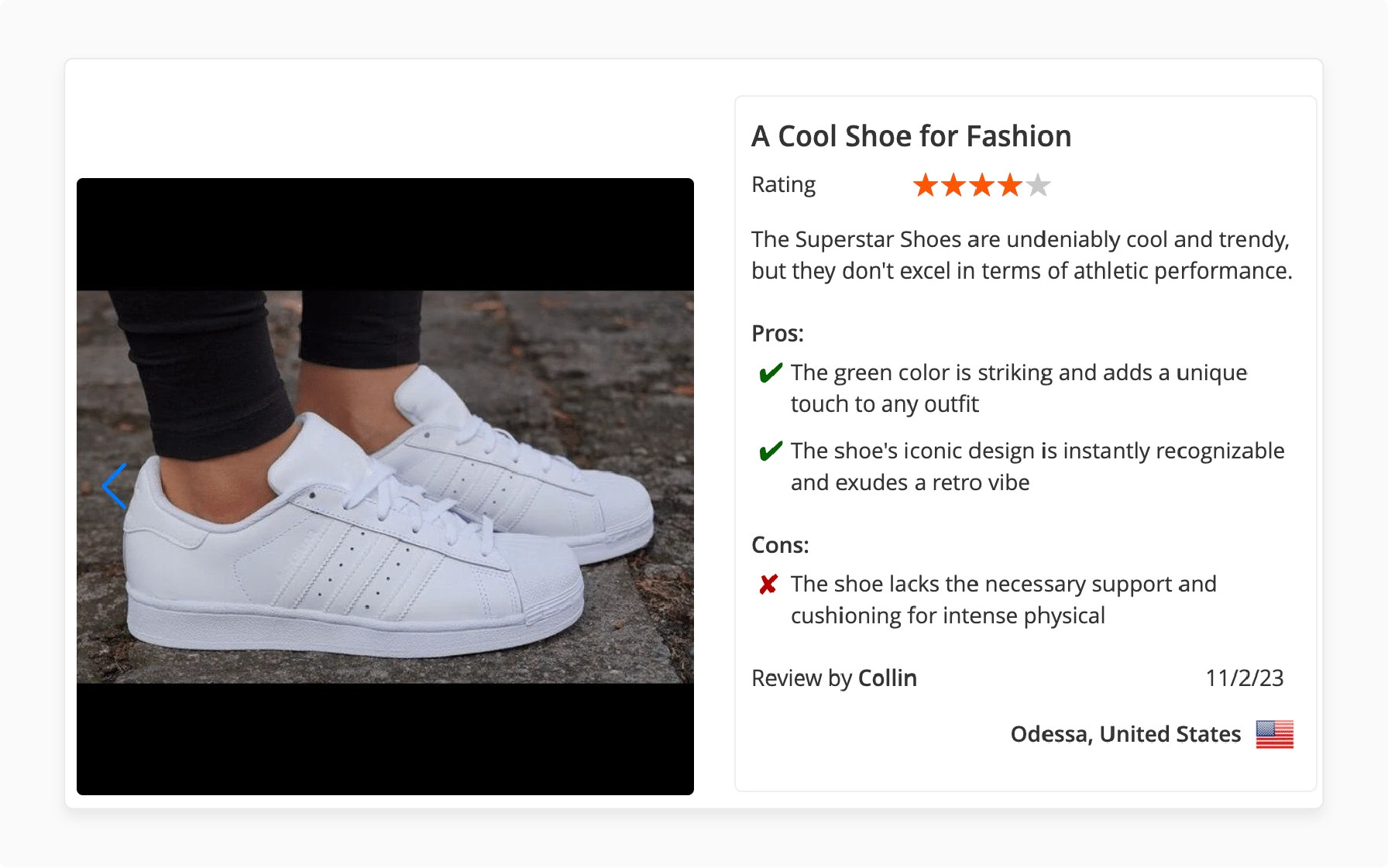
Photos and videos of e-commerce products are popular. They help potential customers make informed purchasing decisions.
Multimedia elements, such as images & videos, provide real-life usage scenarios. Video reviews are especially seen on platforms like Instagram & TikTok. They engage customers with dynamic content & build trust in the product's quality & usefulness.
7 Key Strategies For Ecommerce Product Reviews
1. Request Reviews Via Email Marketing
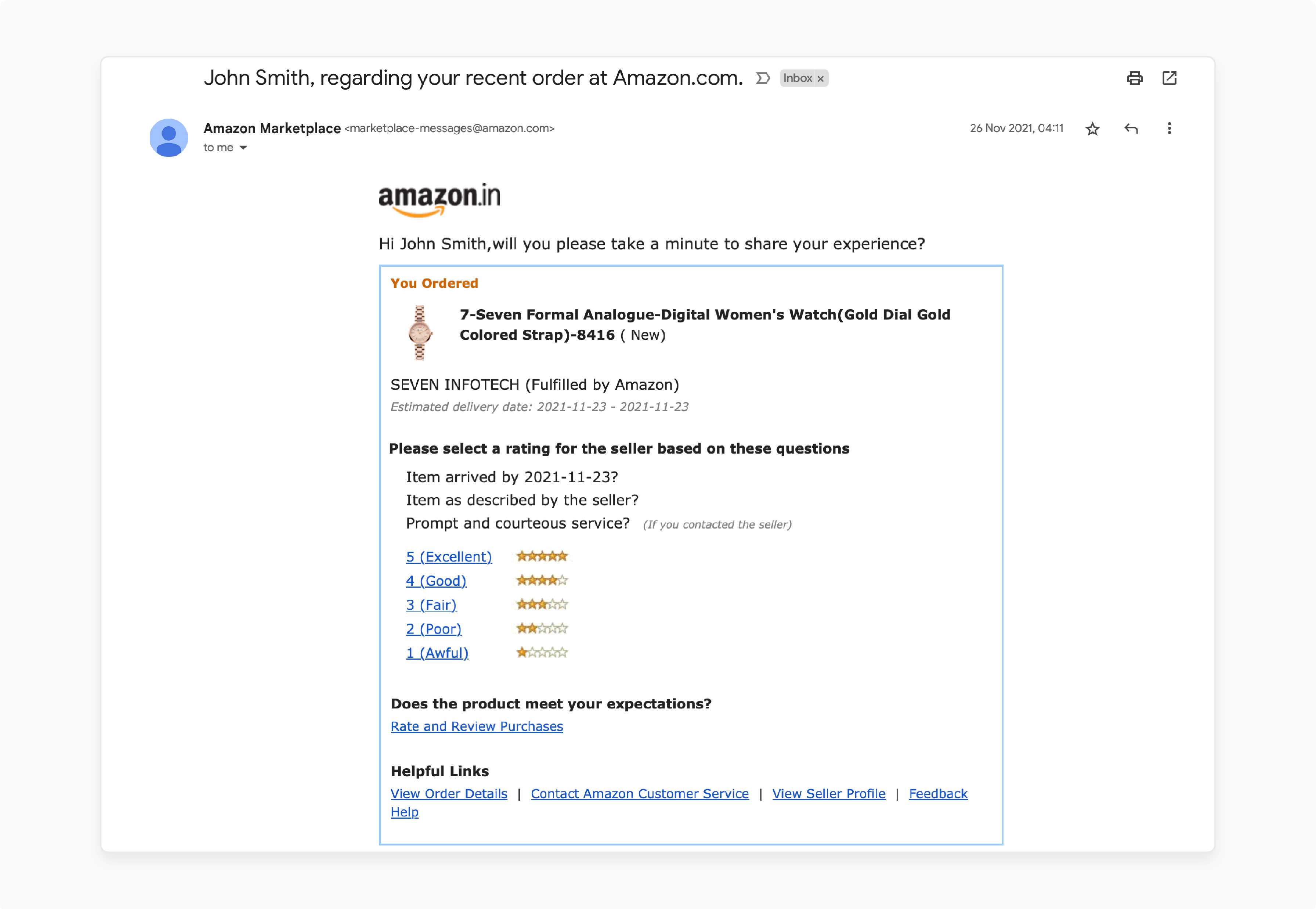
Email marketing helps collect customer reviews for your e-commerce business. Consider the following ecommerce product review email practices when requesting reviews:
- Use email segmentation and automation to enhance your conversion rate & drive sales growth.
- Time your emails in a strategic manner for a better chance of receiving a review.
- Personalize the email for a more personal touch.
- Make the instructions easy to follow for reviews.
- Offer rewards for review submissions.
2. Offer Incentives For Leaving Reviews
Providing incentives is a way to get more reviews from customers. Offer "discounts", "loyalty points", or "gifts" in exchange for leaving feedback. Ensure your incentives align with FTC guidelines and that rewards are well communicated.
3. Make The Review Process Simple
Making the review process simpler helps customers leave reviews in an efficient manner. Add 'buttons' in emails that link to product pages for review. This strategy will increase positive product reviews and help your ecommerce business grow.
4. Use Social Media Channels
You can collect product reviews through social media platforms like 'Facebook'/'Instagram'/'Twitter'. Instagram/TikTok are well-suited for video reviews, with influencer-led content driving significant engagement. Share advertisements & incentives for reviews to increase engagement & your conversion rate for sales.
5. Get Customer Service Teams To Request Reviews
Customer service teams play a key role in generating product reviews. Encourage customers to share their experiences & thoughts on social media. This strategy can benefit your e-commerce business. Showcasing customer reviews on your product pages provides social proof and establishes credibility.
6. Use AI For Review Management
AI tools like 'Yotpo' and 'Bazaarvoice' transform review management. They help automate review requests, analyze sentiment, & provide actionable insights into customer feedback. These platforms make the process smoother and add more personalization. Thus, they make it easier to collect and manage reviews at scale.
You can also create targeted filters to reach specific customer groups, such as:
- Big spenders: Request reviews only from customers who recently purchased high-value items.
- VIPs: Send review requests to customers who have reached a certain lifetime value.
- Repeat buyers: Ask for reviews after a customer's second order.
7. Simplify Review Collection with Automation
Automating your review request process helps you capture feedback at the perfect moment. It is especially evident immediately after a customer interacts with your brand. A quick follow-up email with a rating scale helps customers share their experiences.
Popular tools like 'Boast' and 'JungleScout' make automation easy for ecommerce businesses. You can also use 'Zapier' to integrate and automate requests based on the tools you already use.
Key Benefits of Collecting Ecommerce Product Reviews
| Benefit | Description | Why It Matters | Extra Insights |
|---|---|---|---|
| Improves Conversion Rates | Reviews provide social proof that reassures shoppers about product quality and suitability. | Customers trust real user experiences more than marketing claims. This approach makes them more likely to buy. | Detailed, personal reviews are especially powerful in convincing hesitant buyers. |
| Builds Trust and Credibility | Genuine customer reviews help establish a trustworthy brand reputation that extends beyond self-promotion. | Trust from real users reduces buyer skepticism. It establishes your brand as reliable in a crowded market. | Including both positive & negative reviews shows transparency. This integration further strengthens credibility. |
| Enhances Website SEO | Reviews add fresh, unique content with natural keywords, thereby improving search engine rankings. | Relevant content & keyword diversity help your product pages rank higher & attract organic traffic. | Video reviews and schema markup for rich snippets further enhance SEO & click-through rates. |
| Provides Helpful Customer Insights | Reviews that reveal customer preferences/pain points/product issues. | Brands can use this feedback to improve products/customer experience & drive long-term loyalty. | Negative reviews are useful for product development/service improvement, turning complaints into opportunities. |
| Increases Product Visibility | Positive reviews enhance your product's visibility on search engines/e-commerce platforms. | Higher visibility means more potential customers discover your products. This flexibility lets organizations increase sales opportunities. | Reviews often contain keywords customers use to search. It enables you to tap into new search queries you might not have targeted. |
| Supports Marketing Efforts | Repurposed reviews in emails, social media, ads, and product pages enhance marketing campaigns. | Authentic customer voices in marketing build trust and encourage repeat purchases. | User-generated content from reviews enriches your brand story & attracts new audiences. |
| Creates Customized Buying Experiences | Reviews offer diverse perspectives, helping shoppers find relatable experiences that resonate with them. | Personalized insights reduce uncertainty/help customers make confident choices, improving satisfaction. | Highlight reviews from customers with similar needs or demographics. This approach enables you to target your audience, resulting in enhanced engagement. |
| Boosts Customer Loyalty & Retention | Asking for & responding to reviews engages customers, making them feel valued & heard. | Engaged customers are more likely to return & recommend your brand, driving long-term growth. | Responding to reviews, especially negative ones, shows excellent customer service & builds community trust. |
| Improves Click-Through Rates (CTR) | Rich snippets, including review stars and counts, in search results attract more clicks. | Higher CTR means more traffic to your product pages and increased conversion rates. | Proper schema markup implementation is key to configuring this SEO advantage. |
Top 7 Product Review Sites To Consider for Your Ecommerce Business
1. Your Ecommerce Site
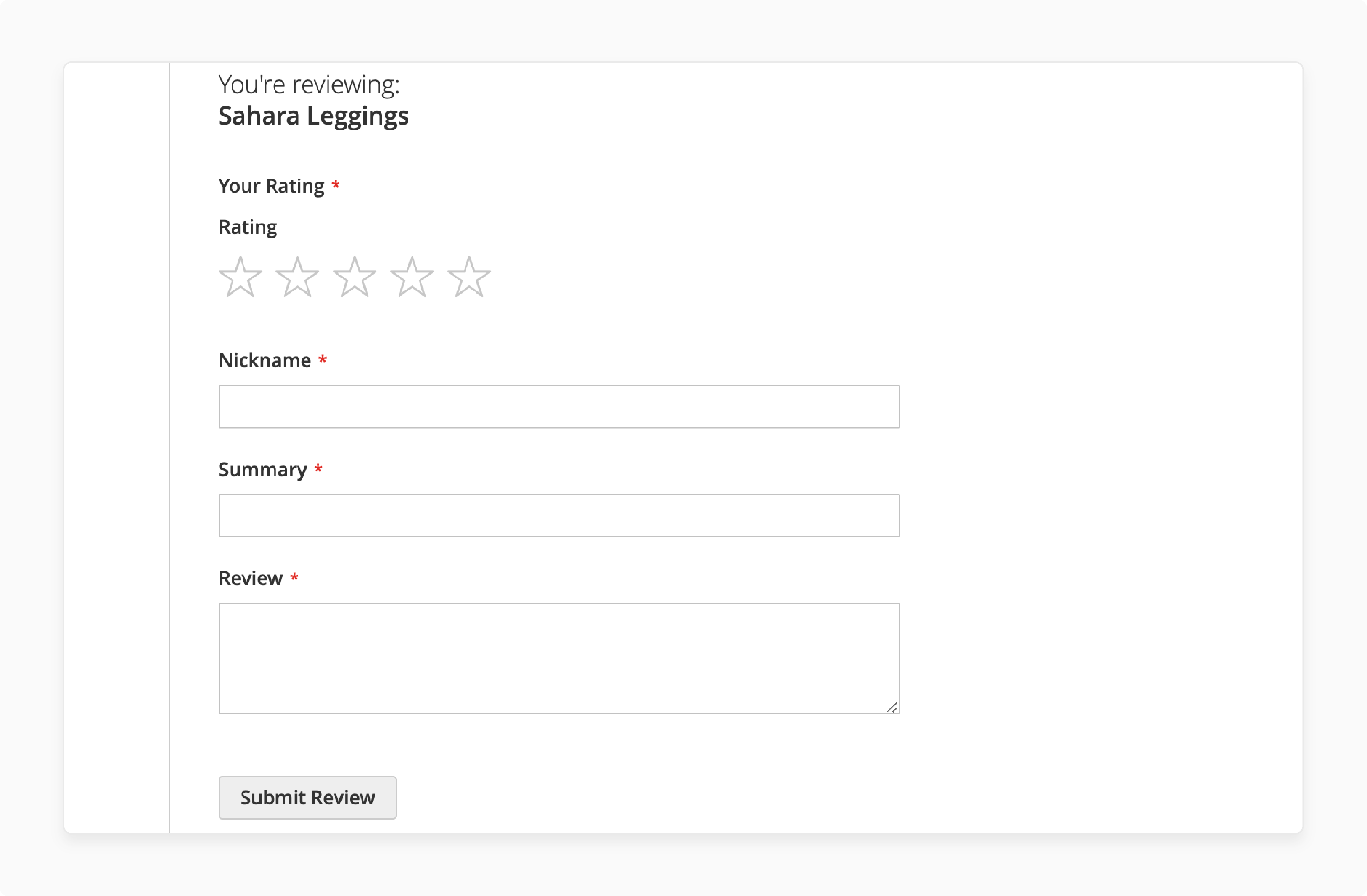
Use tools like 'Yotpo'/'Bazaarvoice'/'Stamped.io' to collect/display reviews on your site. These options help boost SEO and establish trust. These tools help collect authentic and valuable details about:
- What is working well
- What needs work
- How you receive your products
Ensure that you display these customer reviews on your website's product pages. This flexibility allows potential buyers to access them while making informed buying decisions. Reviews also help with search engine optimization. They can increase the number of people visiting your site. User-generated content will attract more organic traffic to the online store.
2. Online Marketplaces
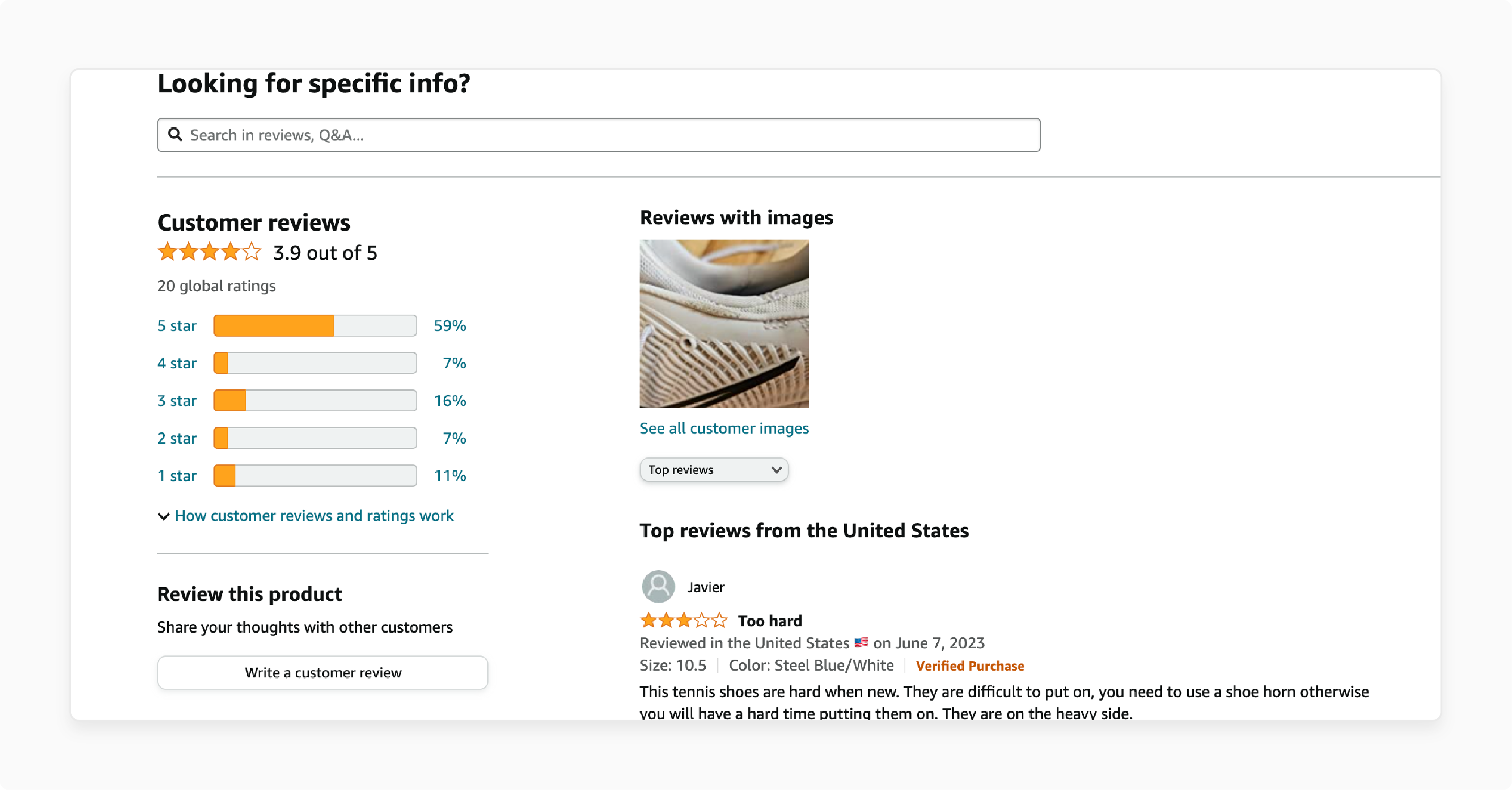
Online marketplaces are popular platforms for e-commerce businesses to sell their products. They have built-in review systems that let customers leave feedback on their purchases. Trust online reviews as much as personal recommendations to help you sell more.
3. Industry-specific Review Sites
Industry-specific review sites are a key consideration when enhancing ecommerce product reviews. They can show you what customers think about your products. Good reviews can attract buyers and raise your brand.
4. Social Media Platforms
Social media platforms are powerful tools for e-commerce businesses. They help promote rewards programs and motivate customers to leave reviews. For example, 'Instagram' & 'Facebook' can showcase satisfied customers using products in real-life situations. These are ideal platforms for 'video reviews', with influencer-led content driving significant engagement.
Retargeting ads on social media can help companies target previous buyers. They can also get them to leave a review for their past purchases.
5. Search Engines
Search engines play a key role in ecommerce product reviews. Google Reviews dominates the landscape. 81% of shoppers check them first, which boosts SEO and conversions. Reviews that contain relevant keywords inform customers. They also help raise the SEO ranking of ecommerce websites.
Search engines, such as Google, pick up these keywords from customer reviews. This process leads to increased organic traffic to product pages & boosts conversion rates.
6. Google Reviews
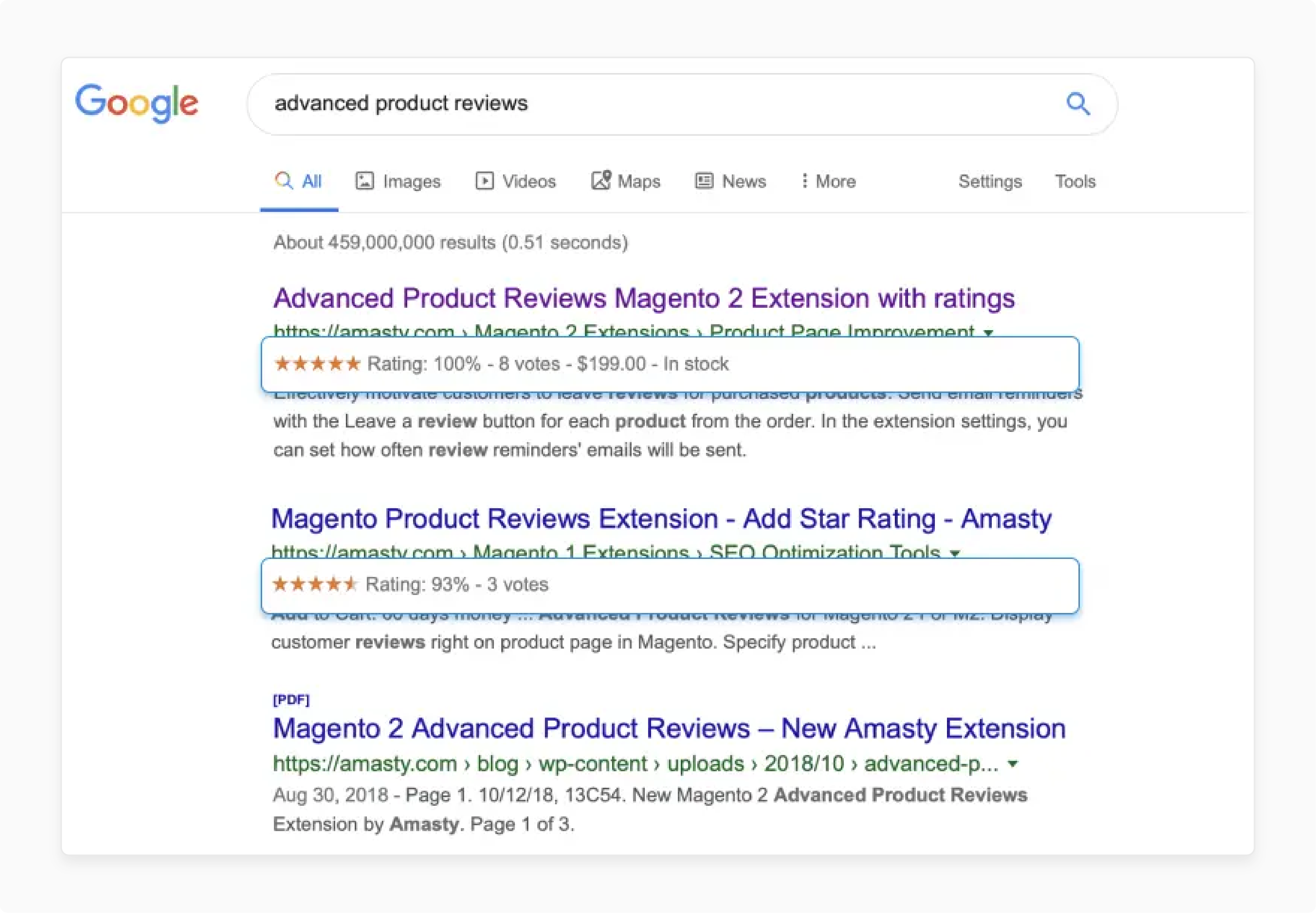
Google Reviews play a key role in Search Engine Optimization. They let customers post feedback on your business profile. It will appear in your search result listing. To start collecting Google Reviews, first create & verify your business profile on Google. Google also adds star ratings to eligible listings, enhancing your visibility.
7. Review Websites
Specialized review platforms serve as trusted hubs for social proof. These include 'Yelp', 'Tripadvisor', & 'Trustpilot'. Reviews on these sites form as customers log in and share their experiences. You don't need to take any action to generate them.
3 Ways To Handle Negative Product Reviews
1. Respond in a Prompt And Professional Manner
Consider the following ways:
- Acknowledge the issue: Show customers that you recognize and address their concerns. Also, take meaningful action to address these issues.
- Apologize with sincerity: Express genuine regret for any inconvenience. Do this even if the negative review seems unfounded.
- Offer a solution: Present a concrete solution to resolve the issue. This step demonstrates that the company prioritizes its customers' satisfaction.
- Maintain a professional tone: Responding in a respectful manner is necessary. Avoid engaging in arguments/personal attacks.
- Take the conversation offline: For complex issues, share customer service contact details. Make it easy for customers to follow up.
2. Offer Solutions To Problems
Negative reviews can be challenging for ecommerce businesses. But they also present an opportunity to showcase excellent customer service/problem-solving skills. Instead of ignoring bad feedback/thinking it doesn't matter, respond in a polite manner. Also, provide suggestions on how to resolve the issue fast in the review.
3. Use Feedback To Make Products And Services Better
Product reviews provide valuable insights for potential customers. They also offer opportunities to improve products and services. Negative feedback can highlight areas of change. Positive feedback can reinforce successful strategies and support growth.
For example, if customers find assembly difficult, offer clearer instructions. You could also create a 'how-to video' for guidance. Online reviews also show how you can help when people encounter problems. Answering fast and in a clear way shows that you want your customers to be happy.
8 Best Practices to Make the Most of Your Ecommerce Product Reviews
1. Display Reviews On Product Pages

Enhance your ecommerce product reviews by displaying them on product pages. Consider using negative feedback to improve products & refine them based on customer reviews. Businesses can use reviews for marketing purposes, allowing users to sort & filter them.
Use review snippets or snapshots to summarize key points and provide relevant information. This approach helps those who may not have time to read through all the comments. It also makes it easy for users to search and filter reviews based on key criteria. Examples include "verified buyer status" and "rating score".
2. Address And Learn From Negative Reviews
Negative reviews can be challenging, but do not ignore them, as they can also help you improve. Talk to the customer and fix the problems. It shows that you want to improve your products. For example, if a customer highlights a flaw, acknowledge it and make improvements. You can also give them a discount to try your product again, as it helps show your customers you care about them.
3. Use Reviews To Make Products & Services Better
Reviews can help you improve your products. Review customer feedback and adjust your products as needed. For example, fix the 'sizing chart' if your clothes are the wrong size. Use reviews to inform the development of new products that cater to customer needs.
4. Repurpose Reviews For Marketing Content
You can use reviews in your ecommerce product marketing. Display customer quotes on your website and social media. This process enables businesses to showcase the quality of their products.
5. Use White-Label Review Management Tools
Simplify your online reputation efforts with white-label review management software. Select a platform that gathers data from your most important review sources on time. The top options include 'Grade.us' and 'Podium'.
6. Turn Top Reviews into SEO & Social Content
Showcase glowing reviews on your website and social media. It enables organizations to build trust and attract new customers. Positive feedback from real users serves as powerful social proof, driving engagement & conversions.
7. Make Reviews Easy to Filter and Sort
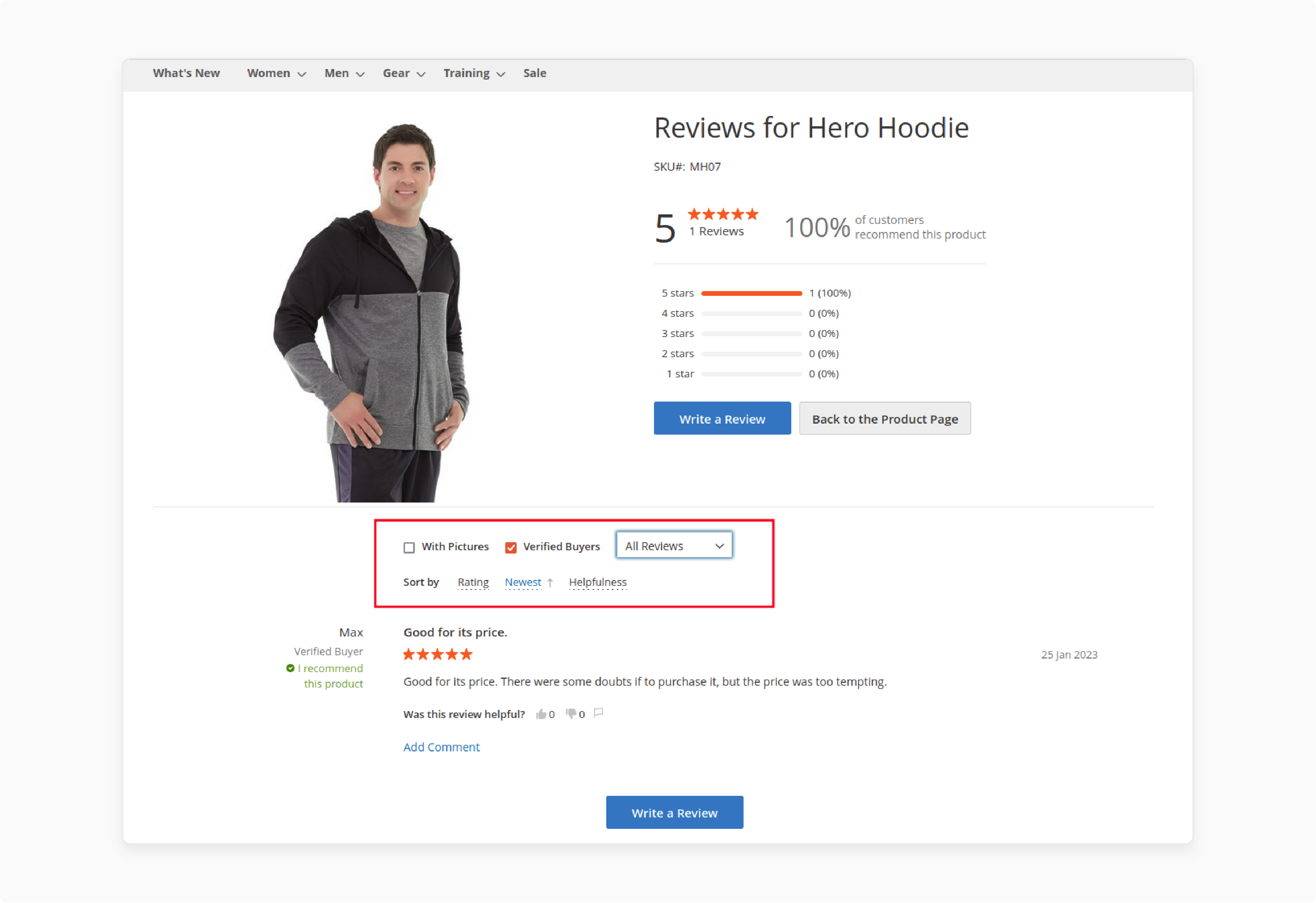
Let customers filter reviews by 'recency'/'rating'/'relevant product attributes' like "size"/"comfort". Most consumers value recent reviews more than older ones, so keep your feedback fresh. Brands like 'Woxer' excel by offering advanced filtering options. Thus, they help improve user experience and boost confidence.
8. Build Loyalty
Reviews help attract new customers and encourage existing ones to return. Strengthen your review strategy. Encourage authentic feedback, learn from customer insights, and respond to reviews across platforms.
Tips to Set Up Ecommerce Product Reviews on Your eCommerce Website
| Tip | Description | Why It Matters | Pro Tips & Extras |
|---|---|---|---|
| Download a Reviews App | Install a reliable product review app like 'Fera', 'Yotpo', or 'Judge.me'. It automates review requests and displays reviews in an attractive manner. |
Automates the review collection process and showcases social proof, boosting trust and sales. | Select apps that support photo & video reviews and SEO features for improved visibility. |
| Create Compelling Incentives | Offer "discounts", "loyalty points", or "cashback" to customers who leave reviews. | Encourages more customers to share honest feedback, increasing review volume and credibility. | Ensure that incentives align with platform policies to avoid penalties. Also, personalize incentives for your target audience. |
| Email Past Customers for Reviews | Send personalized follow-up emails inviting customers to leave reviews on your website. Include "direct links" or "QR codes" for easy access. | Direct requests increase review submissions. They also keep product pages updated with fresh content. | Use automated email sequences post-purchase and keep the review process simple and mobile-usable. |
| Display Reviews on Your Website | Showcase all reviews, including negative ones, on product pages and dedicated review sections. | Transparency builds trust; seeing real feedback helps shoppers make confident buying decisions. | Use 'star ratings', 'filters', and 'sorting options' (by "date", "rating", or "relevance") to enhance UX. |
| Respond to Reviews | Reply to every review, thanking customers or addressing concerns in a professional manner. | Shows you value customer feedback, builds loyalty, and mitigates negative impressions. | Respond in a prompt and thoughtful manner. Turn negative reviews into opportunities to display excellent service. |
| Design a User-Preferred Review Section | Keep the review interface simple, clean, and mobile-responsive. Incorporate interactive elements like "star ratings" and "comment boxes". | Makes it easy and inviting for customers to leave reviews, increasing engagement. | Test on various devices and optimize loading speed. This approach lets you avoid losing reviewers due to frustration. |
| Use Schema Markup for SEO | Configure structured data ('schema markup') on your review pages. This step enables you to add rich snippets to search results. | Improves search engine visibility and click-through rates by displaying "star ratings" & "review counts". | Use 'AggregateRating' & 'Review' schema types, and verify markup daily to maintain SEO benefits. |
| Organize Reviews with Filters and Categories | Allow users to filter reviews by 'rating', 'date', or 'specific features' (e.g., "waterproof," "comfort"). | Helps shoppers find relevant feedback, improving their shopping experience and confidence. | Highlight 'featured' or 'top-rated reviews' with "badges" or "special formatting" to draw attention. |
| Assess Reviews Across Channels | Share positive reviews on 'social media', 'email campaigns', and 'product banners'. This process allows you to amplify social proof. | Extends the impact of reviews beyond your website, boosting brand trust and conversions. | Rotate fresh reviews & integrate them with loyalty/referral programs for a greater impact. |
| Encourage Authentic, Detailed Reviews | Prompt customers to share specific experiences and include photos or videos whenever possible. | Authentic reviews provide richer content for SEO & more persuasive social proof for buyers. | Use apps that support multimedia reviews and AI-driven prompts to increase review quality. |
FAQs
1. How do ecommerce product reviews add value?
E-commerce product reviews are necessary for establishing trust/credibility with potential customers. They provide valuable feedback to help businesses improve their products/services. This approach helps influence potential buyers' decision-making through real-life experiences. Also, they enhance the company's online reputation. These strategies help improve search engine rankings by using user-generated content.
2. How do online reviews impact buyer decisions?
Online reviews have a big impact on buyer decisions. They showcase real customers' experiences & opinions on a product or service. Positive reviews can encourage potential buyers to buy. But negative reviews can deter them.
3. What are the benefits of maintaining a high percentage of positive reviews?
A high number of positive reviews builds customer trust. It also boosts confidence in your products or services. Encourage potential buyers to buy based on others' experiences. Also, enhance your online reputation & establish your business as a trustworthy, high-quality provider.
4. How to develop an effective strategy for generating more product reviews?
Ask customers to share their experiences. Offer incentives for leaving a review. For example, offer discounts/free items. Send follow-up emails after checkout and ask for feedback. Add easy-to-use review forms to your site to simplify the review process.
5. How to get more users to leave product reviews?
To get more customers to leave product reviews, provide exceptional customer service. Positive experiences encourage customers to share feedback. Follow up with simple, personalized requests to make reviewing easy and convenient.
Summary
Ecommerce product reviews help you enhance your products & deliver a superior customer experience. These reviews help you:
- Build trust, boost SEO rankings, or turn customer feedback into sales & business growth.
- Identify and resolve potential issues by analyzing customer data to enhance products & services.
- Gain valuable strategies to make the most out of online reviews.
- Expand your e-commerce presence and address negative feedback in a proactive & effective manner.
- Review trends on social platforms and AI-powered review management tools.
Turn ecommerce product reviews into a business growth boost with Magento hosting plans.
[Updated on June 09, 2025]


